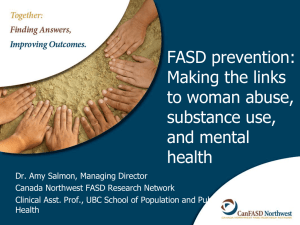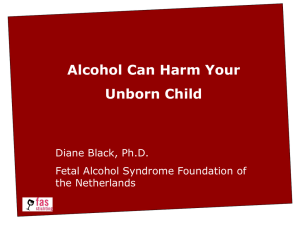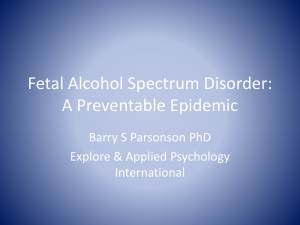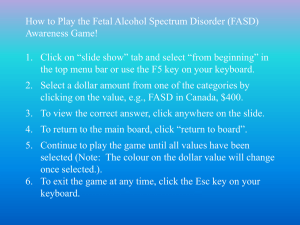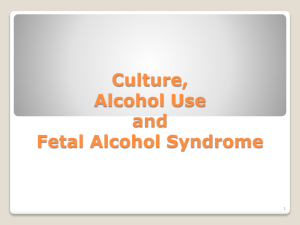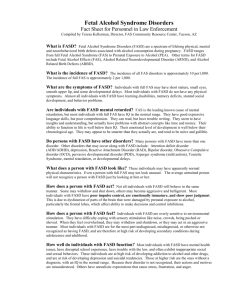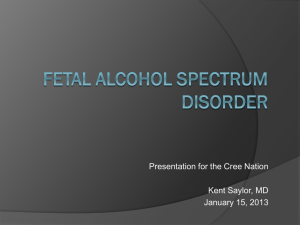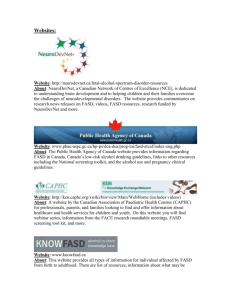Prison Health Best Practices – Developing a Tool Box
advertisement
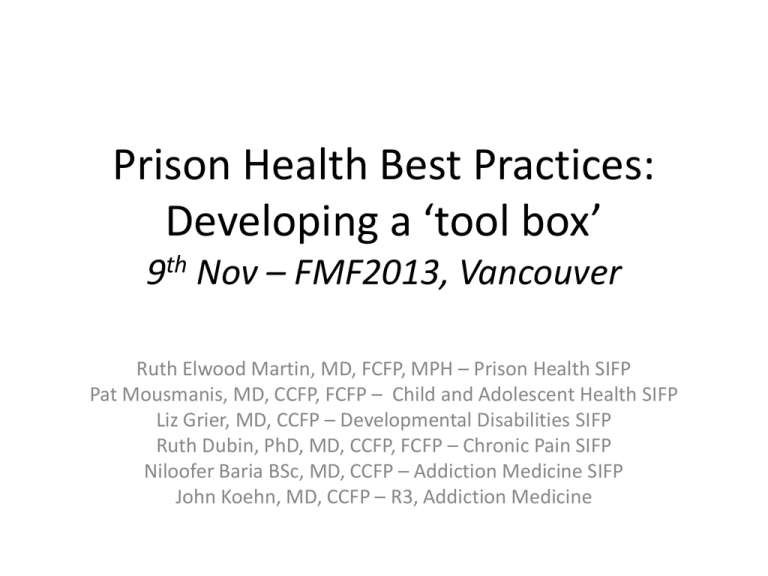
Prison Health Best Practices: Developing a ‘tool box’ 9th Nov – FMF2013, Vancouver Ruth Elwood Martin, MD, FCFP, MPH – Prison Health SIFP Pat Mousmanis, MD, CCFP, FCFP – Child and Adolescent Health SIFP Liz Grier, MD, CCFP – Developmental Disabilities SIFP Ruth Dubin, PhD, MD, CCFP, FCFP – Chronic Pain SIFP Niloofer Baria BSc, MD, CCFP – Addiction Medicine SIFP John Koehn, MD, CCFP – R3, Addiction Medicine Learning Objectives • Discuss some prison clinical scenarios, based on real situations that commonly present in prison health and focusing on addiction, chronic pain, child and adolescent health, and developmental disabilities • Listen to evidence-based ‘best practice’ responses recommended for health care providers in the community and explore their feasibility for prison health care providers within a custodial setting • Contribute to the development of a ‘tool box’ of prison health best practices, as participants network with other physicians, medical students and residents who wish to foster prison health best practices in Canada. Workshop Agenda 8:30 – Introduction to Prison Health SIFP 8:35 – Around the room/table introductions (RM) 8:40 – Review the case and initiate the discussion (RM) 8:45 – DD (PM) and FASD (LG), then Q/discussion 9:10 – Pain (RD), then Q/discussion 9:20 – Addictions response (JK, NB) Pat Mousmanis, MD, CCFP, FCFP Child and Adolescent Health SIFP SCREENING: CRAFFT(teens) • C: Have you ever ridden in a CAR driven by someone (including yourself) who was “high” or using alcohol or drugs? • R: Do you ever use alcohol to RELAX? Feel better about yourself? • A: Do you ever use alcohol while ALONE? • F: Do you ever FORGET things you did while using alcohol? • F: Do your FAMILY/FRIENDS ever tell you to cut down? • T: Have you ever gotten into TROUBLE while using alcohol? CRAFFT: SCORING • Two or more yes responses indicate a potential problem with alcohol • Further assessment is advised RISKS OF HEAVY PRENATAL ALCOHOL USE • Alcohol passes through placenta & fetus has limited ability to metabolize alcohol • Alcohol is known teratogen can damage developing fetal cells, umbilical cord & placenta • Prenatal exposure to alcohol results in: 1. Increased risk of spontaneous abortion and stillbirth 2. Increased risk of FASD (fetal alcohol spectrum disorder) - umbrella term encompassing various effects of alcohol on the developing fetus Most children with an FASD: a) Show no external physical characteristics b) Have low-set ears and small eye openings c) Have a flat groove between the nose and upper lip d) Have a wide nose bridge a) Show no external physical characteristics What percentage of children with FASD end up in the care of people other than their parents? a) b) c) d) 20% 40% 60% 80% d) 80% How many children in foster care may have an FASD? a) b) c) d) 20% 30% 50% 80% c) 50% What percentage of prisoners were likely affected by alcohol in utero? a) b) c) d) 20% 40% 60% 80% c) 60% Children with so-called “mild” effects are at a higher risk than those with severe forms because: a) Doctors treat the most severe cases first b) They look normal and are expected to perform normally c) They are not diagnosed correctly and do not receive appropriate services d) b and c d) b and c Children and youth with an FASD have trouble with: a) b) c) d) Understanding consequences Speaking Trusting people Being kind to animals a) Understanding consequences An 18-year-old with an FASD functions at the level of a child who is: a) b) c) d) 6 years old 9 years old 12 years old 15 years old b) 9 years old Behaviours Associated with an FASD School-Aged Children • Require constant reminders for basic activities at home and school • “Flow-through” Learning: information is learned, retained for a while and then lost • Very concrete thinker, will fall farther behind peers as the world becomes increasingly abstract and concept-based Behaviours Associated with an FASD Adolescents and Adults • Increased truancy • Increased problems linking cause and effect • Problems managing time and money • Difficulty showing remorse or taking responsibility for their actions • Say they understand instructions but can’t carry them out FASD Timelines8 A study of 18-year-old youth with an FASD revealed that they were functioning at the following developmental levels: Organization (self-care hygiene, etc.) like an 11-year-old 11 Social skill development like a 7-year-old 7 Word recognition like a 16-year-old 16 Physical maturity of an 18-year-old 18 Emotional maturity of a 6-year-old 6 Understand time and money like an 8-year-old 8 Think and process like a 6-year-old 6 20 Sound verbally like a 20-year-old 0 10 20 30 FASD Functioning Normal Functioning FASD Functioning Abstract thinking Concrete thinking Able to analyze Can’t analyze Good problem solving Poor problem solving Good judgement Lack common sense Learns by example Learns from experience Learns by repetition Always in trouble Differential Diagnosis of FASD It’s easy to misdiagnose a person as having a more well-known disorder when the person exhibits symptoms common to both disorders Conduct Disorder (CD) Attention Deficit Hyperactivity (ADHD) Oppositional Defiance Disorder (ODD) Autism While each of these is a legitimate separate diagnosis in itself, they may also be diagnostic of a symptom of FASD and thus give only a partial explanation for the constellation of problems experienced by people with FASD8 Cognitive Implications Most people with FASD have no physical features so their “invisible” disability may go undetected Some people have average levels of IQ and appear to understand, so people expect them to perform beyond actual capabilities Psychometric IQ may be too high to qualify a child for special education, however functional IQ may be very low IQ versus Adaptive Functioning • 1996 study of 473 people with FASD9 • IQ ranged from 29 to 142 • 86% had IQ in the “normal” range • Academic skills were below IQ • Living skills, communication skills and adaptive behavior levels were below academic skills FASD Assessments A comprehensive assessment includes input from a multi-disciplinary team including: • Physician • Psychologist • Speech-Language Pathologist • Occupational Therapist S.C.R.E.A.M.S Seven Secrets to Success AAAIIIEEEEEEE! How to minimize screaming (yours, not theirs): Structure with daily routine, with simple concrete rules Cues (again and again and again), can be verbal, audio, visual, whatever works Role models, show them the proper way to act Environment with low sensory stimulation (small classrooms, not too much clutter) Attitude of others, understanding that behaviour is neurological, not willful misconduct Medications, vitamin supplements and healthy diet are quite helpful Supervision - 24/7 (lack of impulse control and poor judgment at all ages) 1998 -2002 Tersa Kellerman www.fasstar.com A Diagnosis for Two? Pregnant women who have already given birth to babies with FASD may have FASD themselves References for FASD 1. 2. 3. 4. 5. 6. 7. 8. 9. Fetal Alcohol Spectrum Disorder (FASD). Public Health Agency of Canada 2005, Cat. No.: H124-4/4004, ISGN: 0-662-68619-5, Publication No.: 4200 Robinson, GC, Conry, JL, Conry, RF. Clinical profile and prevalence of fetal alcohol syndrome in an isolated community in British Columbia. CMAJ 1087; 137(3); 203-7. Williams, RJ, Odaibo FS, McGee JM. Incidence of fetal alcohol syndrome in northeastern Manitoba. Can J Public Health 1999; 90(3): 192-4. Square, D. Fetal alcohol syndrome epidemic on Manitoba reserve. CMAJ 1997; 157(1): 59-60. Habbick, BF, Nanson, JL, Snyder, RE, Casey, RE, Schulman, AL. Foetal Alcohol Syndrome in Saskatchewan: Unchanged incidence in a 20-year period. Can J Pub Health 1996; 87(3): 204-207. Asant, KO, Nelms-Maztke, J. Report on the survey of children with chronic handicaps and Fetal Alcohol Syndrome in the Yukon and Northwest British Columbia. Council for Yukon Indians 1985; Whitehorse, YT. Mueller, Daniel P., Wilder Research Center, Amherst H. Wilder Foundation. Alcohol, Tobacco and Pregnancy: The Beliefs and Practices of Minnesota Women. Minneapolis, MN: Minnesota Department of Public Health, March, 1994, pg. 25-29. Malbin, Diane. Timelines and FAS/FAE, Adapted from research findings of Streissguth, Clarren et al., 1994 A Layman’s Guide to Fetal Alcohol Syndrome and Possible Fetal Alcohol Effects, FAS/E Support Network of B.C. 1997 pg. 43-44 SIFP Prison Health Best practices workshop FMF - 2013 Dr. Liz Grier, MD, CCFP Chair – Developmental Disabilities Program Committee FASD and Adulthood Physical Health Issues – congenital heart disease, renal defects, congenital vision and hearing deficits • if childhood health unknown may wish to consider: echo, renal US, vision/hearing Ax Dysmorphic features of FAS/FAE diminish over time (microcephaly, long philtrum, thin vermillion border, even short stature and underweight) Mental handicaps persist including intellectual disability (avg IQ 68, academic fn 2nd-4th grade), limited occupational options and ability for independent living including navigating health, social and educational/vocational systems Maladaptive Behavioural Problems are significantly increased including poor judgement, distractibility, impulsivity and difficulty perceiving social cues Importance of considering both Cognitive and Adaptive Functioning Definitions: • “cognitive functioning” means a person’s intellectual capacity, including the capacity to reason, organize, plan, make judgments and identify consequences. • “adaptive functioning” means a person’s capacity to gain personal independence, based on the person’s ability to learn and apply conceptual, social and practical skills in his or her everyday life Services and Supports to Promote the Social Inclusion of Persons with Developmental Disabilities Act, Ontario, 2008, c.14, s.3 (2). • Genetic and Environmental factors influence intellectual and adaptive functioning Intellectual vs. Adaptive Functioning con’t • Discrepancies are important to identify: –Low IQ scores but strong adaptive skills • Ex. 21 year old man with IQ of 70 with strong interpersonal skills and family support network attends an adapted college program, lives in a supported independent living, can manage many IADLs –Borderline IQ scores but impairments in adaptive functioning • Ex. 21 year old man with IQ of 80 with co-morbid FASD and chaotic home environment. Moved frequently as a child, attending many different schools, IEPs not put in place, poor literacy skills and difficulties with attention, impulsivity and difficulties perceiving social cues make it very difficult for him to work and manage independent living Developmental Disabilities Program Committee Resources • Sullivan et al. Primary care of adults with developmental disabilities: Canadian consensus guidelines. Canadian Family Physician May 2011 vol. 57 no. 5 541-553 • Guidelines Overview: – General Issues – Physical Health – Mental Health • Clinical Tools and CME opportunities/Clinical Support • FASD Health Watch Table – in final stages of publication LINK to DDPC Website Importance of Identification of Developmental Disability in the Criminal Justice System Highly Vulnerable in community – limited understanding of legal terminology, court proceedings, their rights and cooperating with attorney, confessing during interrogation -anxious to fit in – ‘cloak of competence’, ‘cheating to lose’, ‘halo effect’ -rates of ID are high in inmates: studies show 4-10% with mild ID (up to 5 fold of the rates in the general population), and an additional 10% with borderline ID -many of these individuals are not diagnosed -difficulties following rules or recommendations (including health related), highly vulnerable to victimization by other inmates, receive little in the way of services on release Hayes Ability Screening Index (HASI) -validated instrument to screen for ID in prison system (Sens 82%, Spec 72%) -can be administered by non psychologists, 5-10 min to administer, culture and gender fair, available in Canadian French References Hayes S. et al Early Intervention or early incarceration? Using a screening test for intellectual disability in the criminal justice system. Journal of Applied Research in Intellectual Disabilities, 2002(15):120-128 Hayes Ability Screening Index (HASI) 2002-2013 University of Sydney, Department of Behavioural Sciences in Medicine Herrington, V. Assessing the prevalence of intellectual disability among young male prisoners. J Intellect Disabil Res 2009 May;53(5):397-410 O’Leary et al. Prenatal Alcohol Exposure and Risk of Birth Defects Pediatrics 2010;126;e843 Scheyett et al. Are we there yet? Screening processes for intellectual and developmental disabilities in jail settings. Intellect Dev Disabil. 2009 Feb;47(1)13-23 Sondenaa et al. The prevalence and nature of intellectual disability in Norwegian prisons. J Intellect Disabil Res. 2008 Dec;52(12):1129-37 Sphor et al. Fetal Alcohol Spectrum Disorders in Young Adulthood J Pediatr 2007;150:175-9 Streissguth et al. Fetal Alcohol Syndrome in Adolescents and Adults JAMA 1991;265:1961-1967 Ruth Dubin, PhD, MD, CCFP, FCFP Chronic Pain SIFP Managing chronic pain in correctional settings • Joey says he’s had pain ever since an accident at age 19, when he jumped through a 3rd story window during a police chase. At that time he suffered a “broken back in 3 places” (you assume compression vertebral fractures to 3 lumbar vertebrae), “both ankles broken and I still have metal pins in both ankles”, 6 broken ribs and lacerations of upper body from the glass (he has ++ scars). • • “How are you going to help my pain, doctor?” Questions: • How would you approach this patient? • What additional information would you like to know on history? • What would you like to know on physical examination? • What is your proposed treatment plan? Elements of a Good Pain History (But you don’t have to do it all in one visit) 1. Current pain descriptions (including pain scoring) 2. Previous pain history (including treatments and results) 3. Current treatments, effectiveness and adverse effects 4. Other concurrent medical/psych problems 5. Social history (family, work, income, relationships) 6. Addiction screening 7. Current functioning and future goals 8. GOOD DOCUMENTATION The 4 + 2 A’s of pain assessment • • • • • • Analgesia (BPI) Adverse reactions Activities of daily living (BPI) Aberrant behaviour (Addicts have pain too) Affect (include sleep) (BPI) Accurate Medication log, accurate records Brief Pain Inventory BPI Interference Score is 63/70 JOEY’S PAIN DIAGRAM WHY DO WE ASK ABOUT PAIN QUALITY? Neuropathic? – burning, stabbing, tingling, electric shocks Myofascial? – tearing , pressure can hurt first and then relieve, NOT responsive to medications Nociceptive – worse with motion: symptoms correspond to ‘observable’ tissue damage Inflammatory – AM stiffness, red/swollen/tender, though CNS inflammation increasingly researched in all chronic pain “Other” – fibromyalgia (Chronic widespread pain) – central sensitization, deficient DNIC (Descending neurogenic inhibitory control) Visceral – Irritable bowel, interstitial cystitis: common in fibromyalgia Mixed - osteoarthritis, low back pain GREAT Myofascial Pain APP “Real Bodywork (itunes)” Myofascial Pain Does Not Respond to OPIATES! You can use trigger point injections, acupuncture, TENS, stretching, Yoga, And other Manual Therapies Hx and Pe • Joey describes his pain as burning, like ants running on his legs and he hates wearing tight clothing • His sleep is really disrupted by the pain • He feels anxious, and depressed “if I didn’t have so much pain I wouldn’t be buying drugs on the street” • When you lightly touch his legs and his back he winces. A safety pin in these areas feels “worse than the time I was stabbed”. • There are no temperature, hair growth or skin colour changes on his legs The ideal treatment of Chronic Pain* MOVEMENT Physical / Rehabilitative Sleep Matters! SELF MANAGEMENT MIND Psychological MEDICINE Medications & Interventions *(R Jovey, Canadian Pain Society,2009-with input from R.Dubin) Also see: Action Plan for the organization and delivery of chronic pain services in Nova Scotia, 2006 Treatment Options for Pain PHYSICAL Normal activities Splinting / Taping Aquafitness Physio • Passive • Active Stretching Conditioning Weight training Massage TENS Transcranial Magnetic Stimulation Chiropractic Acupuncture Dolphin PSYCHOLOGIC PHARMACOLOGIC INTERVENTIONAL Hypnosis Stress Management CognitiveBehavioural Family therapy Psychotherapy MindfulnessBased Stress Reduction Mirror Visual Reprogramming OTC medication Alternative therapies Topical medications NSAIDs / COXIBs DMARDs Immune modulators Tricyclics Anti-epileptic drugs Opioids Local anesthetic congeners Muscle relaxants Sympathetic agents NMDA blockers CGRP blockers I.A. steroids I.A. hyaluronan Trigger pt. therapy IntraMuscular stim. Prolotherapy Nerve blocks Epidurals Orthopedic surgery Radio frequency facet neurotomy Neurectomy Implantable stimulators Implantable pain pumps Modified “WHO Analgesic Ladder” g n i as e r c In n i a P Moderate Pain Mild Pain Acetaminophen ASA / NSAIDs Tramadol (+/- adjuvants) Severe Pain Hydromorphone Morphine Codeine +/Tramadol +/Oxycodone +/acetaminophen (+/- adjuvants) Oxycodone Fentanyl Methadone (+/- adjuvants) Butrans patch Tapentadol Adapted from The WHO 3 Step Analgesic Ladder, His pain will be worse if he has Hep C due to general inflammation Acetaminophen*Suggested Dose Ceilings • 4 gm/day – short-term use in healthy patients (FDA Advisory Report 2009 – lower the ceiling dose) • 3.2 gm / day chronically in healthy patients (>10 d) • 2.6 gm / day chronically in at risk patients* *Daily alcohol consumption, warfarin, fasting, a low protein diet, cardiac or renal disease increase the risk of hepatotoxicity Zimmerman & Maddry, 1995 Seeff et al., 1986 Swarm et al., 2001 Bromer MQ, Black M. Acetaminophen hepatotoxicity. Clin Liver Dis 2003;7:351-67 Latta, 2000 Garcia Rodriguez, Arthritis Res 2001; Curhan 2002 Watkins et al., 2006. Pharmacologic Treatment of Neuropathic Pain TCA Gabapentin or Pregabalin Add additional SNRI Topical Lidocaine* agents sequentially if partial but Tramadol or CR Opioid Analgesic inadequate pain relief** Fourth Line Agents * * e.g., carbamazepine, cannabinoids, methadone, lamotrigine, topiramate ** In using multiple agents, be aware of synergistic or additive adverse effects Moulin DE et al. Pain Res Manag 2007;12(1):13-21. You diagnose Neuropathic Pain possible Pseudo-addiction* or maybe Addiction • Given his sleep disorder and symptoms what medications might you recommend? • How will your management here differ from treating someone in the community? • What might be effective treatments for him given his drug misuse and pain issues? *Pseudo-addiction occurs when patients seek drugs to manage their pain. The drug-seeking behaviour disappears when the pain is properly managed. Prison Health Best Practices: Developing a “Tool Box” Addiction Medicine John Koehn, MD, CCFP . FMF 2013 Addiction in the Prison Setting • Diagnosis of substance use disorder often assumed • No documented substance history • Prescribing decisions made on an institution-wide basis • Addiction issues treated as a social or behavioural problem Substance Use History Evidence-based Addiction Treatment • Treating addiction as a medical issue • Screening and making a diagnosis while incarcerated • Thinking beyond the prison gates: aftercare planning
